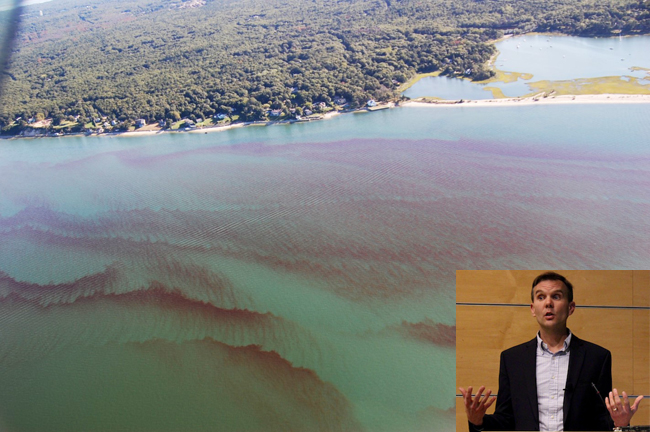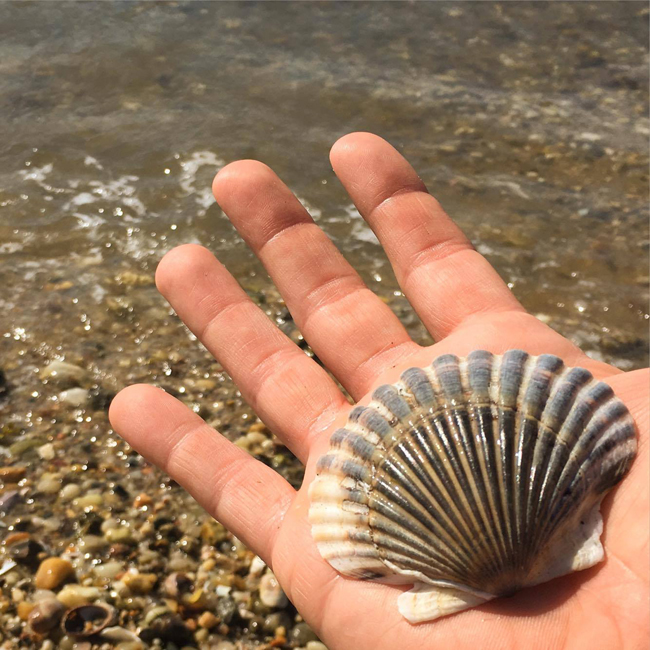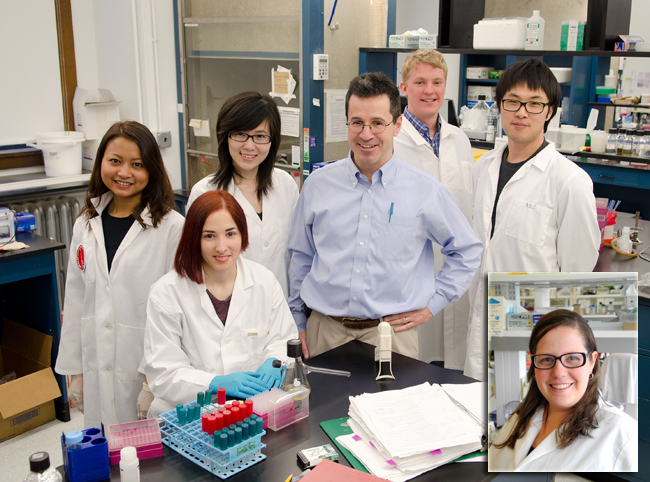New York, NY, June 15, 2018 - Scientists funded by New York Sea Grant are, in a new suite of projects that began this past spring, seeking solutions for harmful algal blooms and better aquatic invasive species detection, as well as ocean acidification, flood risk, and a pervasive microbic food-borne pathogen.
For more on the effort, see the May 2018 press release "Over $1.1M for New York Sea Grant Research in 2018-2019."
Below are stories filed by Cornell University and Stony Brook University's press offices in late May — early June 2018, after the projects were first announced ...
$1.1 Million Secured for New York Sea Grant Research Projects

According to Gobler, 2017 was one of the worst years for brown tide and red tides that cause paralytical shellfish poisoning. It covered the entire south shore of Long Island by early June and persisted through late July in Great South Bay, pictured here. Credit: Auxiliary Coast Guard.
Published for Stony Brook University's E-news Site, Happenings
Stony Brook, NY, May 31, 2018 - Five new two-year coastal research projects are now underway and all are being administered at Stony Brook University. Two of the projects are being led by Christopher Gobler, Endowed Chair of Coastal Ecology and Conservation, and Associate Professor Bradley Peterson from the School of Marine and Atmospheric Sciences at Stony Brook. The projects — funded with a total amount awarded of more than $1.1 million — are sponsored by New York Sea Grant (NYSG) and funded through the National Oceanographic and Atmospheric Administration (NOAA), Sea Grant’s federal parent agency.
“These new projects target issues of importance to New Yorkers and to citizens everywhere,” said William Wise, director of New York Sea Grant. “Our approach of linked research, outreach, and extension raises awareness about coastal resources and enhances the sustainability of coastal communities.”

A scallop shell washed ashore in Long Island’s Noyac Bay. These and other aquatic filter feeders face survival challenges in bays, estuaries and other waters due to a number of water quality issues that Bradley Peterson will study. Credit: Paul C. Focazio.
Gobler’s research aims to better understand nutrients in sediment and their connection to harmful algal blooms (HABs). He will host workshops on HABs and water quality in Long Island estuaries and study concentrations and exchanges of nitrogen (a growth nutrient for various algal blooms) between estuarine sediments and the overlying waters. HABs degrade water quality and can lead to hypoxia (oxygen-depleted waters), acidification (a process by which absorption of carbon dioxide gas produces a pH imbalance in these waters, making them more acidic), fish kills, and decline in valuable bivalve species (oysters, clams, mussels, scallops).
“Many of New York’s estuaries already face seasonal acidification and hypoxia,” said Gobler. “These conditions will intensify with near-term climate change.” As confirmed in related studies, Gobler added, “It is important that regions and species of bivalves least susceptible to these conditions be identified now in order to maximize the resilience of New York’s bivalve populations and seafood supply for the future.”
Peterson’s project will explore connections between seagrasses and ocean acidified waters. He will assess the ability of seagrass to draw down carbon dioxide from the water, which could reduce the effects of ocean acidification. Peterson’s team will also determine if seagrass-modified water benefits adjacent habitats. Seagrasses could provide refugia — areas of more favorable conditions for calcified organisms such as corals and crustaceans — from the surrounding acidified waters. As such, the ecosystem services provided by seagrass could reduce the negative impacts of ocean acidification.
The other three projects focus on better aquatic invasive species detection, flood risk, and a pervasive microbic food-borne pathogen.
Cornell studies to protect Great Lakes coastal regions

Shoreline erosion in 2017 in Hamlin, New York. Credit: Mary Austerman/New York Sea Grant.
By Kara Lynn Dunn, publicist for New York Sea Grant Great Lakes Extension
Published in Cornell Chronicle
Ithaca, NY, June 7, 2018 - Three grants from the New York Sea Grant (NYSG), a National Oceanographic and Atmospheric Administration (NOAA) program, will aid Cornell coastal science research projects along the Great Lakes.
Researchers in the College of Agriculture and Life Sciences received more than half of the $1.1 million in grants announced by NYSG for two-year coastal science research projects.
Cornell projects will focus on Great Lakes coastal flooding and aquatic invasive species detection, and developing ways to help seafood processors fine-tune their listeria food safety control strategy.
Tools to help coastal communities address flood risk and planning:
Scott Steinschneider, assistant professor in the Department of Biological and Environmental Engineering, will use a $237,431 grant to develop models of extreme lake levels, storm surges and wave heights to help predict flooding events, such as the high water events along Lake Ontario in 2017. Social science data will supplement development of decision-support tools for flood risk and planning.
Enhancing aquatic invasive species detection with e-DNA:
David M. Lodge, director of the Atkinson Center for a Sustainable Future and a professor in the Department of Ecology and Evolutionary Biology, received $239,630 to develop an inexpensive environmental DNA-testing method for earlier detection of aquatic invasive species, and co-detection of multiple species to assist coastal resource managers at less cost than current detection methods. Field testing will take place on lakes Erie and Ontario.
Amplifying food safety for salmon processors:
Dr. Martin Wiedmann, the Gellert Family Professor in Food Safety in the Department of Food Science, received $170,000 to assess how listeria grown under different processing conditions before contamination of salmon differs in susceptibility to the antibacterial compound nisin. Listeria contaminates a variety of foods at levels unlikely to cause disease, but can grow to dangerous levels. The research of Wiedmann and postdoctoral associate Veronica Guariglia will take into account natural growth conditions that listeria is exposed to in seafood processing facilities. The goal is to help processors in the Great Lakes and downstate saltwater regions of New York customize their use of nisin for cold-smoked salmon product packaging.

Research by Dr. Martin Wiedemann (seen in his laboratory with technicians) and post-doc associate Dr. Veronica Guariglia (inset) will assist salmon processors with the use of the antibacterial nisin. Photos: Cornell University.
The projects are sponsored by New York Sea Grant, a cooperative program of Cornell and the State University of New York and one of 33 university-based programs in NOAA’s National Sea Grant College Program.
“New York Sea Grant is pleased to sponsor this new research that is vital to protect and enhance the quality of New York state’s water resources, which are an essential economic driver not only for our coastal communities in the Great Lakes region but for all of New York state,” said Katherine Bunting-Howarth, associate director of New York Sea Grant Institute and assistant director of Cornell Cooperative Extension.
More Info: New York Sea Grant
New York Sea Grant (NYSG), a cooperative program of Cornell University
and the State University of New York (SUNY), is one of 33 university-based
programs under the National Oceanic and Atmospheric Administration’s
National Sea Grant College Program.
Since 1971, NYSG has represented a statewide network of integrated
research, education and extension services promoting coastal community
economic vitality, environmental sustainability and citizen awareness
and understanding about the State’s marine and Great Lakes resources.
Through NYSG’s efforts, the combined talents of university scientists
and extension specialists help develop and transfer science-based
information to many coastal user groups—businesses and industries,
federal, state and local government decision-makers and agency managers,
educators, the media and the interested public.
The program maintains Great Lakes offices at Cornell University, SUNY
Buffalo, SUNY Oswego and the Wayne County Cooperative Extension office
in Newark. In the State's marine waters, NYSG has offices at Stony Brook
University in Long Island, Brooklyn College and Cornell Cooperative
Extension in NYC and Kingston in the Hudson Valley.
For updates on Sea Grant activities: www.nyseagrant.org has RSS, Facebook, Twitter, and YouTube links. NYSG offers a free e-list sign up via www.nyseagrant.org/nycoastlines for its flagship publication, NY Coastlines/Currents, which is published quarterly. Our program also produces an occasional e-newsletter,"NOAA Sea Grant's Social Media Review," via its blog, www.nyseagrant.org/blog.